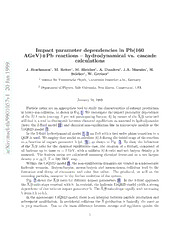
Impact parameter dependencies in Pb(160 AGeV)+Pb reactions -- hydrodynamical vs. cascade calculations PDF
Preview Impact parameter dependencies in Pb(160 AGeV)+Pb reactions -- hydrodynamical vs. cascade calculations
Impact parameter dependencies in Pb(160 AGeV)+Pb reactions – hydrodynamical vs. cascade calculations 9 9 9 J. Brachmann1, M. Reiter1, M. Bleicher1, A. Dumitru2, J.A. Maruhn1, H. 1 St¨ocker1, W. Greiner1 n 1 a Institut fu¨r Theoretische Physik, Universita¨t Frankfurt a.M., Germany J 0 2 Department of Physics, Yale University, New Haven, Connecticut, USA 2 1 v January 18, 1999 7 5 0 Particle ratios are an appropriate tool to study the characteristics of entropy production 1 0 in heavy-ion collisions, as shown in Fig. 1. We investigate the impact parameter dependence 9 of the S/A ratio (entropy S per net participating baryon A) by means of the Λ/p ratio and 9 will find it a tool to distinguish between chemical equilibrium as assumed in hydrodynamics / h (here: the 3-fluid model [1]) and chemical non-equilibrium like in microscopic models as the t - l UrQMD model [3]. c u In the 3-fluid hydrodynamical model [1, 2] an EoS with a first order phase transition to a n QGP is used. We employ that model to calculate S/A during the initial stage of the reaction : v as a function of impact parameter b (cf. [2]), as shown in Fig. 2. To show the behaviour i X of the Λ/p ratio for the chemical equilibrium case, the creation of a fireball, composed of r all hadrons up to mass m = 2 GeV, with a uniform S/A ratio and net baryon density ρ is a assumed. The hadron ratios are calculated assuming chemical freeze-out at a net baryon density ρ = ρ0/2, T = 160 MeV, resp. . Within the UrQMD model [3], the non-equilibrium dynamics are treated in a microscopic hadronic scenario. Baryon-baryon, meson-baryon and meson-meson collisions lead to the formation and decay of resonances and color flux tubes. The produced, as well as the incoming particles, rescatter in the further evolution of the system. Fig. 2 shows the Λ/p ratio for different impact parameters [4]. In the 3-fluid approach the Λ/p ratio stays constant with b. In contrast, the hadronic UrQMD model yields a strong dependence of this ratio on impact parameter b. The Λ/p ratio drops rapidly with increasing b from 1.3 to 0.5. In the microscopic UrQMD model, there is an interplay between particle production and subsequent annihilation. In peripheral collisions the Λ production is basically the same as in p+p reactions. Due to the mass difference between strange and up/down quarks the 1 production of (anti-)strange quarks is suppressed, which results in a suppression of Λ over p by a factor of 2. In central Pb+Pb encounters meson-baryon and meson-meson interactions work as additional sources for the anti-hyperon and anti-proton production and additional rescattering has to be taken into account in the hot and dense medium. Anti-baryons are strongly affected by the comoving baryon density and annihilate, while, according to the additive quark model, the annihilation probability for Λ’s is smaller, leading to an increase of the Λ/p ratio above 1. Thus, in the UrQMD [3] chemical equilibrium may only be established in very central reactions, where enough secondary collisions drive the system into chemical equilibrium. In contrast, the fluids of the hydrodynamical calculation are, by 1 definition, in chemical equilibrium. References [1] J. Brachmann, A. Dumitru, J.A. Maruhn, H. St¨ocker, W. Greiner, D.H. Rischke, Nucl. Phys. A 619, 391 (1997); A. Dumitru, J. Brachmann, M. Bleicher, J.A. Maruhn, H. St¨ocker, W. Greiner, Heavy Ion Physics 5, 357 (1997) [2] M. Reiter, A. Dumitru, J. Brachmann, J.A. Maruhn, H. St¨ocker, W. Greiner, Nucl. Phys. A 643, 99-112 (1998) [3] S. A. Bass et al., Prog. Part. Nucl. Phys. 41, 225 (1998); M. Bleicher et al, J. Phys. G, to be published [4] M. Bleicher, M. Reiter, A. Dumitru, J. Brachmann, C, Spieles, S.A. Bass, H. St¨ocker, W. Greiner, hep-ph/9811459 1In the beginning of the reaction kinetic equilibrium between the fluids is not assumed, but chemical equilibrium is established by assumption of an EoS. 2 Figure 1: Specific Entropy S/A vs. Impact parameter b. Circles denote the S/A values from the 3-fluid model. Diamonds and squares denote the ratios of pions to baryons and deuterons to protons (logarithmic), resp., as calculated from the S/A values. Triangles show the ‘S/A’ values parametrized by S/A = 3.945+ln(d/p)+4(π/n ). p Figure 2: Impact parameter dependence of the Λ/p ratio in Pb(160 AGeV)+Pb reactions [4]. The full squares denote the UrQMD calculations, the lines show the 3-Fluid Hydro + Fireball calculation including a first order phase transition (full line: freeze-out at ρ = ρ0/2, dashed line: freeze-out at T = 160MeV). 3
